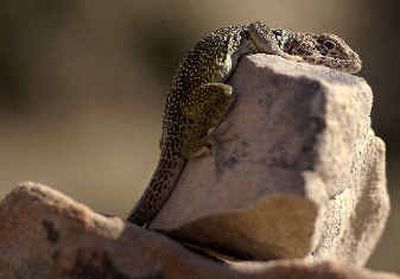Ojito Mesa could become next refuge for lovers of outdoors

ALBUQUERQUE, N.M. — Wild enough to get lost in, tame enough for youngsters to follow porcupine and coyote tracks, Ojito Wilderness is about to become an official nature-lover’s paradise.
Unofficially, it is Albuquerque City Councilor Martin Heinrich’s 11,000-acre field of dreams, drawing national attention that he says is long overdue.
“I have hiked in Ojito for many years, and I’m always discovering something new,” he tells those looking for adventure or pure silence not far from Albuquerque.
Only a 45-minute drive north from the city near the Jemez Mountains, Ojito is home to golden eagles and mountain lions, a hiding place for ancient pueblo ruins, petroglyphs and dinosaur skeletons.
The land is adjacent to the Zia Pueblo. The Zia word for Ojito is Puni, meaning “land to the west.”
A replica of the 110-foot Ojito seismosaurus — one of the largest dinosaurs ever discovered — is on display at the New Mexico Museum of Natural History.
“Ojito is unlike any other place I know and keeps me coming back,” Heinrich said. “This is New Mexico desert at its best.”
As a consultant to the Coalition for New Mexico Wilderness, Heinrich worked three years to help unite government agencies, tribal leaders and conservationists behind the movement to protect Ojito under the 1964 Wilderness Act.
Wilderness areas like this don’t get congressional approval every day. Heinrich and hundreds of New Mexicans supporting the Ojito Wilderness Act are pushing passage this year. There is no opposition, although at one time botanists feared they would lose public access to rare plants in the area.
The federal agency that manages the area favors wilderness designation.
For 13 years, Donna Dudley of the Bureau of Land Management has been patrolling the Ojito area as an outdoor recreation planner. She will be able to continue her work under the wilderness plan.
“I am here for the duration,” she said. “I think it’s a beautiful area. It’s not too often you can find areas like this so close to the city.”
She said traffic in the Ojito area is picking up, but traffic on the remote roads means seeing two cars parked.
“You’d still probably not see the whites of anybody’s eyes,” she said. “It’s like a little oasis out there where you feel like you are totally alone in the world.”
Dudley said the BLM has always supported the wilderness designation for Ojito. The agency did an inventory of the qualities of wilderness which was the basis for former President Bush’s decision to designate Ojito as a wilderness study area.
“It’s been sitting in a drawer waiting for Congress” since then, she said.
Recreational activities, including hunting, hiking, camping and bird-watching, as well as grazing, would continue under the wilderness designation, but motorized vehicles, mining and logging will not be allowed.
Congressional hearings began in July, but Congress recessed for the month of August. Heinrich predicts a September vote.
For eight years, Heinrich hiked and photographed these badlands and redrock mesas, looking for fossils, petrified wood and wildlife. He knows most of the native plants by name.
Hoodoo Pines, within the Ojito, is an area of mushroom-shaped, sandstone hoodoos and 300-year-old Ponderosa pines growing at a low elevation where they are rarely found.
Leaning down to touch a wildflower, he notes: “A couple of weeks ago these four o’clocks were in bright bloom.”
The vistas, wildlife, and rare plants — some still unnamed, others waiting to be discovered — have drawn study groups to Ojito for years. Wilderness education is expected to flourish as the area becomes better known.
Heinrich said his years exploring the wilderness with study groups made him realize how badly it needed federal protection.
“If you don’t do something to actively protect an area, it will disappear,” he said.
Heinrich is working on a Web site that will guide visitors to the area and “help people know where to go, where not to go.”
Ojito has been a wilderness study area since 1991 when then-Interior Secretary Manuel Lujan Jr. of New Mexico recommended wilderness protection.
Finally, the Ojito Wilderness Act this month arrived at the House Resources Subcommittee on National Parks, Recreations and Public Lands for a hearing that should lead to its approval and federal protection. The act also provides for the sale of adjacent BLM land to the Pueblo of Zia, which has agreed to manage it as public open space.
The bill would create the first new wilderness area in New Mexico since 1987.